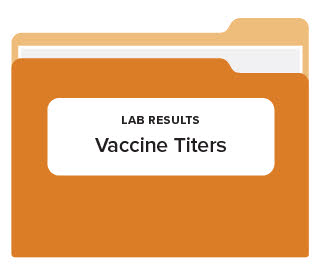Vaccine titer report

Illustration by Tamara Rees/VIN
Your pet receives vaccines on a set schedule to protect them from illness. Vaccines tell the body to make immune cells and antibodies, which work to prevent or reduce the severity of specific diseases. A vaccine titer is a measure of disease-specific antibody levels in the blood. A higher titer means higher antibody levels and potentially greater protection for the animal.
Although vaccine titers have historically been expensive, their use is increasing as they become more affordable and easier to measure. Veterinarians sometimes use vaccine titers to decide whether to revaccinate a pet at the scheduled time. The basic idea is that if your pet has enough antibodies to protect them against a disease, revaccination against that disease may not be necessary. It is important to note that this only applies to the following vaccines:
The first three are core vaccines for dogs, while FPV is a core vaccine for cats. Core vaccines are recommended for all pets because the diseases they protect against are widely distributed and can cause significant illness and death. Although titers can be used to make decisions about these core vaccines, it is important to note that titers do not matter for the rabies vaccine, another core vaccine. Legally, the rabies vaccine must be given at certain time intervals, regardless of how high the rabies antibody titer may be in your pet.
Why can't titers be used for all vaccines?
The body makes antibodies in response to both vaccination and infection. Therefore, if your pet has high antibody levels against a disease, this can tell us one of three things:
- Your pet is currently infected with the disease.
- Your pet was vaccinated or exposed to the disease.
- Your pet is protected from the disease.
- How do we know which is correct? It partly depends on the disease we're talking about.
For some diseases, high antibody levels do not mean your pet is protected. Therefore, your pet should be revaccinated as scheduled against these diseases, regardless of titer results.
For a few diseases, however, high antibody levels do seem to predict protection from illness. These diseases are canine distemper virus, canine adenovirus, canine parvovirus and feline panleukopenia virus (FPV). Thus, a high titer for these diseases likely means your pet is protected enough to not need revaccination at that time. Meanwhile, a low titer might suggest the need for revaccination against these diseases, as your pet may not have enough protection.
When should vaccine titers be used?
Vaccine titers may be useful in a few scenarios. Remember, these scenarios apply only to vaccines against canine distemper virus, canine adenovirus, canine parvovirus and FPV.
- If your puppy or kitten will be traveling a lot, you might want to check their vaccine titers 2 to 4 weeks after they complete their initial vaccine series. If the titers are too low, they should be revaccinated.
- Although it is uncommon, some dogs and cats have severe adverse reactions to vaccines. If this applies to your pet, vaccine titers can assess whether your animal needs to be revaccinated against the diseases listed above. If their titers are high enough, they likely have sufficient protection and can avoid revaccination at that time.
- If you adopt an adult dog or cat with an unknown vaccination history, vaccine titers can indicate whether they need vaccines against canine distemper, canine adenovirus, canine parvovirus or FPV. If their titers are high enough to protect them, they don't need to be vaccinated against those diseases at that time. However, if their rabies vaccination history is unknown, they must be vaccinated against rabies.
- Although it is very rare, some animals are “genetic non-responders” who are unable to make lots of antibodies when given a certain vaccine. These animals can be identified through consistently low antibody levels despite multiple revaccinations.
Does a low vaccine titer mean my pet is not protected from disease?
Not necessarily. Vaccines tell the body to make both antibodies and immune cells. The antibody levels decline faster than the levels of immune cells do. So, even if your pet has very few antibodies, they might have enough immune cells to defend them against disease. Unfortunately, it is hard to measure these immune cells, so a low titer may suggest the need for revaccination. Ultimately, this decision should be up to your veterinarian.
It is worth noting, however, that the above does not apply to puppies and kittens. If your puppy or kitten has low antibody levels after completing their initial series of vaccines up to at least 16 weeks of age, they are not protected and thus they should be revaccinated.
How often should vaccine titers be measured?
That decision should be left to the individual veterinarian and the pet owner.
What are the cons of doing vaccine titers?
- A high titer does not promise 100% protection from disease.
- As with any lab test, there is always the potential for error, meaning the titer may say your pet has enough antibodies when they actually don't.
- Vaccine titers only give a snapshot of your pet's antibody levels at a single moment in time, telling us nothing about future immunity. This means that antibodies may decline to insufficient levels before your pet's next vaccine titer is scheduled.
- Vaccine titers have historically been expensive for pet owners. Fortunately, they are becoming more affordable but the cost may still be a barrier for many pet owners.
If you're interested in vaccine titers, you should consult your veterinarian about whether they would be a useful option for your pet. They can be a valuable tool in determining whether revaccination is necessary, but they may not be suitable for every animal.